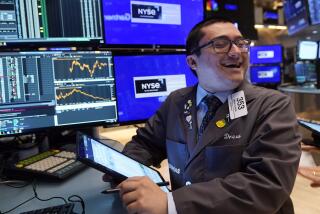UNCERTAINTY IN THE FINANCIAL MARKETS : Plunging Nikkei Signals Shift to Cash Economy
- Share via
TOKYO — By custom, it should have been a great week for the Tokyo stock market.
Friday was the halfway point in the Japanese fiscal year, the day corporations must use to value their stock holdings. For weeks, brokers had been boasting about how prices would climb as their sales forces, in an effort to please their corporate clients, drummed up new buyers and pushed up share prices.
This practice of ramping up prices to serve corporate interests is so common at this time of year that one Daiwa Securities trader bravely predicted last week that the Nikkei 225-stock index would climb more than 10% to 26,000 in the final week of September.
No such luck. Even an army of brokers couldn’t turn the tide. Instead, pummeled by high interest rates, soaring oil prices and weakening land prices, the Nikkei fell 2,794 for the week, crashing through the 21,000 mark seen by many as an important support level to close Friday at 20,983.50.
Rumors of war in Iraq temporarily brought the market down even more sharply on Friday before institutional investors came in to stage a minor rally.
With the market already down 46% from its high of 38,915 late last year, few expect to see another crash. But analysts say another 20% drop during the coming months is not inconceivable.
The price drop represents not merely an adjustment in what had been an inflated market but a major structural change in Japan’s financial markets, many observers said.
“Since World War II, stock market declines of 40% have only happened four times. Each time represented a period of structural change,” said a senior executive of one major Japanese brokerage who asked not to be named.
The latest drop brought an end to a four-year period in which the entire economy focused on the value of assets rather than on income, he said. In words that have become a cliche in Japan, he called the latest structural change a switch from focusing on “stock” to looking at “flow,” meaning cash flow.
Driven by a sharp appreciation of the yen at the end of 1985 and the drop in oil prices, interest rates fell. That, in turn, fueled speculation in land.
Stock prices also shot up, with investors focusing not so much on earnings as on a company’s “hidden assets”--usually premium land not reflected on the company’s balance sheet.
With a focus on assets rather than earnings, stock prices rapidly outpaced economic and earnings growth.
In 1980, the total value of the roughly 1,300 Japanese stocks traded in the first section of Tokyo Stock Exchange was about one-third of the nation’s total economic output, or gross national product. By 1989, the stocks were worth $4.44 trillion, 1 1/2 times the nation’s total GNP. The ratio paralleled that seen on Wall Street before the 1929 crash. Price-to-earnings ratios reached 60, four times U.S. levels.
This inflation in asset prices allowed Japanese corporations and individuals to borrow huge sums which they then reinvested, again driving up prices and leaving the country awash in cash.
All that has changed. The forces that were driving stocks in an upward spiral until last year have been turned on their heads. Now those forces are pushing prices into a downward spiral.
High interest rates have made it more costly for investors to hold land and stocks that produce little income.
Banks are being forced to cut their lending as their capital base, made up largely of land and stocks, has shrunk in value. Some analysts worry that a credit crunch could eventually force some borrowers into bankruptcy.
“If you see the bankruptcy of some large-sized companies, it could even trigger a panic,” said Josen Takahashi, chief researcher at Mitsubishi Research Institute.
“If property prices come down too fast, it could bring the whole system down,” said Taek Chong, general manager of Schroder Securities Ltd.’s Tokyo office.
Even the best-case scenario sees a sluggish market during the next six months.
High-priced oil, meanwhile, is driving up interest rates and cutting into corporate earnings. Since Iraq’s invasion of Kuwait, higher oil prices have cost corporate Japan $29 billion beyond its normal oil bill, according to financial analyst Akimoto Kogiso.
With long-term bonds in Japan yielding 8.2%, money is leaving stocks and going into bonds.
At current interest rates, the Nikkei index would have to fall to about 18,000 before stocks would be attractive again, one analyst said.
At that point, shares would sell for about 25 times earnings. They would still get a 100% premium compared to U.S. stocks, but Tokyo analysts say that is justified by the competitiveness of Japan’s firms and the strength of its economy relative to the U.S. economy.
The optimists aren’t giving in. Since the U.S. Federal Reserve Board eventually will be forced to ease U.S. interest rates to revive the economy, they have argued, the differential between U.S. and Japanese interest rates will eventually disappear. That will draw money back into Japan, driving interest rates down. Once Japanese long-term bonds again yield about 6.5%, Tokyo stocks will take on a new shine.
But even the greatest optimists admit that could take a long time. And for all the talk about patient investing, Japanese investors don’t appear ready to wait it out.
More to Read
Inside the business of entertainment
The Wide Shot brings you news, analysis and insights on everything from streaming wars to production — and what it all means for the future.
You may occasionally receive promotional content from the Los Angeles Times.










